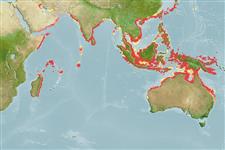>
Eupercaria/misc (Various families in series Eupercaria) >
Cepolidae (Bandfishes) > Cepolinae
Etymology: Acanthocepola: Greek, akantha = thorn + Latin, cepulla, cepa = onion.
More on author: Valenciennes.
Environment: milieu / climate zone / depth range / distribution range
Ökologie
seewasser benthopelagisch; tiefenbereich 10 - 80 m (Ref. 127963). Tropical; 31°N - 29°S, 47°E - 155°E
Indo-West Pacific: Persian Gulf, Vietnam, Indonesia (Java to Flores and West Papua), Philippines, Papua New Guinea (Port Moresby to Milne Bay), and Australia (Queensland; Northern Territory and Western Australia).
Size / Gewicht / Alter
Maturity: Lm ? range ? - ? cm
Max length : 30.0 cm TL Männchen/unbestimmt; (Ref. 11441)
Rückenflossenweichstrahlen (insgesamt) : 69 - 80; Afterflossenstacheln: 0 - 2; Afterflossenweichstrahlen: 70 - 84; Wirbelzahl: 45 - 49. This species is characterized by the following: HL 6.3-8.4 in SL; preopercle with 5 blunt spines, the longest at angle. Colouration: head and body orange-pink with double series of yellow spots (smaller than pupil) on the sides; dorsal fin yellow-orange, anal fin yellow and median fins with narrow black margins; paired fins yellow with pink rays (Ref. 127963).
Occurs in muddy habitats, usually in large colonies, each individual with its own burrow. Rises high above the substrate in schools to feed when plankton drifts over, typically in vertical posture (Ref. 48635).
Life cycle and mating behavior
Geschlechtsreife | Fortpflanzung | Ablaichen | Eier | Fecundity | Larven
Kailola, P.J., 1987. The fishes of Papua New Guinea: a revised and annotated checklist. Vol. II Scorpaenidae to Callionymidae. Research Bulletin No. 41, Research Section, Dept. of Fisheries and Marine Resources, Papua New Guinea. (Ref. 6192)
IUCN Rote Liste Status (Ref. 130435: Version 2024-1)
Bedrohung für Menschen
Harmless
Nutzung durch Menschen
Fischereien:
Tools
Zusatzinformationen
Download XML
Internet Quellen
Estimates based on models
Preferred temperature (Ref.
123201): 25.6 - 29.1, mean 28.3 °C (based on 674 cells).
Phylogenetic diversity index (Ref.
82804): PD
50 = 0.5625 [Uniqueness, from 0.5 = low to 2.0 = high].
Bayesian length-weight: a=0.00339 (0.00183 - 0.00629), b=2.85 (2.67 - 3.03), in cm total length, based on LWR estimates for this species & (Sub)family-body (Ref.
93245).
Trophic level (Ref.
69278): 3.4 ±0.45 se; based on food items.
Widerstandsfähigkeit (Ref.
120179): hoch, Verdopplung der Population dauert weniger als 15 Monate. (Preliminary K or Fecundity.).
Fishing Vulnerability (Ref.
59153): Low vulnerability (20 of 100).
